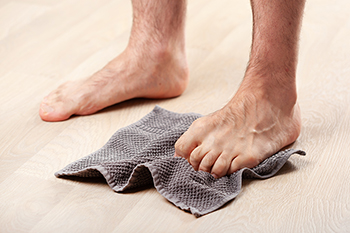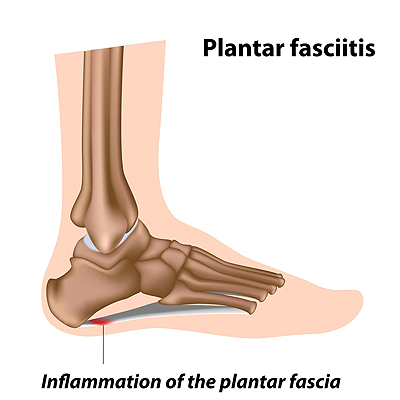
Ingrown toenails are a common yet uncomfortable and potentially painful foot condition. This unsightly condition occurs when the side of a toenail essentially grows into the skin. If the toenail is cut too short or if it has a natural curved shape, the nail may be especially prone to growing into the skin. This condition is most common in the big toe. There are a variety of home remedies to treat ingrown toenails. However, if these remedies do not work or if you have multiple ingrown toenails, your podiatrist may recommend undergoing a surgical procedure. This procedure might include removing part of the nail or the entire affected nail. Many patients are curious to know whether or not this procedure is painful. Although each patient’s experience is unique, there is information about this procedure that may be applicable to you. For example, before the surgical procedure, you may need an anesthetic injection that can potentially be uncomfortable for some patients. However, many patients report that the actual procedure following the injection is quite painless. After the procedure, you might experience pain when the numbness slowly abates. To treat this pain following the procedure, you might be able to use over-the-counter medications. If you are curious about the pain you could feel during a surgical procedure to remove an ingrown toenail, speak to your podiatrist.
Ingrown toenails can become painful if they are not treated properly. For more information about ingrown toenails, contact Dr. Kendall Blackwell of InStride Wilson Podiatry Associates. Our doctor can provide the care you need to keep you pain-free and on your feet.
Ingrown Toenails
Ingrown toenails occur when a toenail grows sideways into the bed of the nail, causing pain, swelling, and possibly infection.
Causes
Prevention
Because ingrown toenails are not something found outside of shoe-wearing cultures, going barefoot as often as possible will decrease the likeliness of developing ingrown toenails. Wearing proper fitting shoes and using proper cutting techniques will also help decrease your risk of developing ingrown toenails.
Treatment
Ingrown toenails are a very treatable foot condition. In minor cases, soaking the affected area in salt or antibacterial soaps will not only help with the ingrown nail itself, but also help prevent any infections from occurring. In more severe cases, surgery is an option. In either case, speaking to your podiatrist about this condition will help you get a better understanding of specific treatment options that are right for you.
If you have any questions please feel free to contact our office located in Wilson, NC . We offer the newest diagnostic and treatment technologies for all your foot and ankle needs.

The pain from a severe gout attack can be debilitating. Many patients find it difficult to walk, and even the weight of a bed sheet can be disturbing. Gout is a type of arthritis that is brought on by an excess amount of uric acid in the blood. This converts to crystals, and can lodge in the joints of the big toe. Gout can develop from genetic reasons, leading a sedentary lifestyle, or from eating foods that are not healthy. These include an excess of red meat, shellfish or alcohol, or from having drinks that are made with large amounts of sugar. There may also be existing medical conditions that can lead to gout. Among these are obesity, high blood pressure, diabetes, or kidney damage. A proper diagnosis of gout involves having a blood sample drawn that can determine the uric acid level. In severe cases, there may be a needle inserted into the affected joint, and an analysis of the fluid. Relief may be found when the foot is elevated, and this may help to diminish a portion of the swelling that often accompanies gout. If you have gout attacks, it is strongly advised that you are under the care of a podiatrist who can properly diagnose and treat this condition.
Gout is a foot condition that requires certain treatment and care. If you are seeking treatment, contact Dr. Kendall Blackwell from InStride Wilson Podiatry Associates. Our doctor will treat your foot and ankle needs.
What Is Gout?
Gout is a type of arthritis caused by a buildup of uric acid in the bloodstream. It often develops in the foot, especially the big toe area, although it can manifest in other parts of the body as well. Gout can make walking and standing very painful and is especially common in diabetics and the obese.
People typically get gout because of a poor diet. Genetic predisposition is also a factor. The children of parents who have had gout frequently have a chance of developing it themselves.
Gout can easily be identified by redness and inflammation of the big toe and the surrounding areas of the foot. Other symptoms include extreme fatigue, joint pain, and running high fevers. Sometimes corticosteroid drugs can be prescribed to treat gout, but the best way to combat this disease is to get more exercise and eat a better diet.
If you have any questions please feel free to contact our office located in Wilson, NC . We offer the newest diagnostic and treatment technologies for all your foot and ankle needs.

Patients who are diabetic may be familiar with wound care for the feet. Elevated blood sugar levels may cause a foot ulcer to gradually develop and immediate treatment may be necessary to avoid further implications, including amputation in severe cases. There are several types of foot ulcers that diabetic patients may experience. Neuropathy can cause a lack of feeling in the foot and patients are unable to feel the pain caused by an injury. A loss of blood flow to the feet can lead to an ischemic ulcer which can be difficult to treat. If the patient has poor circulation and neuropathy, a neuroischemic ulcer may form and it is said to be the most difficult to heal. Approximately half of foot ulcers become infected, therefore they need to be closely monitored. Diabetic foot ulcer treatment begins with removing infected tissue from the wound. This is called debridement and it is crucial in the prevention of damaged nerves, blood vessels, and tendons. This is followed by reducing existing pressure on the foot ulcer and draining the wound. If you have diabetes, it is strongly advised that you are under the care of a podiatrist who can treat and manage diabetic foot problems.
Wound care is an important part in dealing with diabetes. If you have diabetes and a foot wound or would like more information about wound care for diabetics, consult with Dr. Kendall Blackwell from InStride Wilson Podiatry Associates. Our doctor will assess your condition and provide you with quality foot and ankle treatment.
What Is Wound Care?
Wound care is the practice of taking proper care of a wound. This can range from the smallest to the largest of wounds. While everyone can benefit from proper wound care, it is much more important for diabetics. Diabetics often suffer from poor blood circulation which causes wounds to heal much slower than they would in a non-diabetic.
What Is the Importance of Wound Care?
While it may not seem apparent with small ulcers on the foot, for diabetics, any size ulcer can become infected. Diabetics often also suffer from neuropathy, or nerve loss. This means they might not even feel when they have an ulcer on their foot. If the wound becomes severely infected, amputation may be necessary. Therefore, it is of the upmost importance to properly care for any and all foot wounds.
How to Care for Wounds
The best way to care for foot wounds is to prevent them. For diabetics, this means daily inspections of the feet for any signs of abnormalities or ulcers. It is also recommended to see a podiatrist several times a year for a foot inspection. If you do have an ulcer, run the wound under water to clear dirt from the wound; then apply antibiotic ointment to the wound and cover with a bandage. Bandages should be changed daily and keeping pressure off the wound is smart. It is advised to see a podiatrist, who can keep an eye on it.
If you have any questions, please feel free to contact our office located in Wilson, NC . We offer the newest diagnostic and treatment technologies for all your foot care needs.

Foot pain is a common ailment among many people. The feet undergo daily stress while walking, standing, or running for much of the day. Diabetic patients may be familiar with the pain associated with a foot ulcer and sometimes surgery is necessary for proper healing. Diabetics may also be affected by neuropathy, which is the inability to feel cuts, bruises, or scrapes on the feet. This happens from having elevated blood glucose levels. An uncomfortable foot condition known as athlete’s foot can cause severe redness and itching. Athlete’s foot originates from a fungus and is contagious. A bony protrusion that forms on the side of the big toe is known as a bunion and can occur from wearing shoes that do not have adequate room for the toes to move freely in. Having an ingrown toenail becomes painful as the nail grows into the skin instead of over it. Surgery is sometimes a necessary treatment option so the toe can properly heal. If you have any type of foot pain, it is strongly suggested that you use the services of a podiatrist who can properly diagnose and treat foot pain.
Foot Pain
Foot pain can be extremely painful and debilitating. If you have a foot pain, consult with Dr. Kendall Blackwell from InStride Wilson Podiatry Associates. Our doctor will assess your condition and provide you with quality foot and ankle treatment.
Causes
Foot pain is a very broad condition that could be caused by one or more ailments. The most common include:
Diagnosis
To figure out the cause of foot pain, podiatrists utilize several different methods. This can range from simple visual inspections and sensation tests to X-rays and MRI scans. Prior medical history, family medical history, and any recent physical traumatic events will all be taken into consideration for a proper diagnosis.
Treatment
Treatment depends upon the cause of the foot pain. Whether it is resting, staying off the foot, or having surgery; podiatrists have a number of treatment options available for foot pain.
If you have any questions, please feel free to contact our office located in Wilson, NC . We offer the newest diagnostic and treatment technologies for all your foot care needs.

Many people endure foot problems at some point in their lives. A foot injury may have caused the foot to become lethargic and performing specific exercises may help to get strength and movement back. This can promote accelerated tissue healing and can help to gradually return to normal activities. When starting a new exercise regime after a foot injury it is important to pay attention to different levels of pain that may exist. If the pain increases, it is advised to reduce the number of repetitions and to decrease the speed of the motion. Additionally, it can help to increase resting times between sets to give the affected foot ample time to recharge. Many patients prefer stretching exercises which can help improve range of motion. As soon as a gentle stretch is felt it is advised to hold it for approximately 20 seconds. Movement exercises can build strength and agility and they are performed in repetitions of eight, followed by a brief resting period, and then repeating. If you would like more information about the benefits exercise can have on the feet, please consult with a podiatrist who can answer any questions you may have.
Exercising your feet regularly with the proper foot wear is a great way to prevent injuries and build strength. If you have any concerns about your feet, contact Dr. Kendall Blackwell from InStride Wilson Podiatry Associates. Our doctor can provide the care you need to keep you pain-free and on your feet.
Exercise for Your Feet
Exercise for your feet can help you gain strength, mobility and flexibility in your feet. They say that strengthening your feet can be just as rewarding as strengthening another part of the body. Your feet are very important, and we often forget about them in our daily tasks. But it is because of our feet that are we able to get going and do what we need to. For those of us fortunate enough to not have any foot problems, it is an important gesture to take care of them to ensure good health in the long run.
Some foot health exercises can include ankle pumps, tip-toeing, toe rises, lifting off the floor doing reps and sets, and flexing the toes. It is best to speak with Our doctor to determine an appropriate regimen for your needs. Everyone’s needs and bodies are different, and the activities required to maintain strength in the feet vary from individual to individual.
Once you get into a routine of doing regular exercise, you may notice a difference in your feet and how strong they may become.
If you have any questions please feel free to contact our office located in Wilson, NC . We offer the newest diagnostic and treatment technologies for all your foot and ankle needs.

Ankle pain may be caused by any number of factors including arthritis in the joints, tears in ankle ligaments, swollen/scar tissue, and bone or cartilage injuries. An ankle arthroscopy can help podiatrists diagnose and repair many issues that cause ankle pain. An arthroscope is a tiny camera that a podiatrist can insert through a small incision in the skin to capture real-time video inside your ankle. The video is displayed on a large video monitor that the podiatrist looks at to help make an accurate diagnosis of ankle pain. The podiatrist can also use this video to guide them as they use tiny instruments, which are inserted through other small incisions, to treat/repair the condition causing the ankle pain. This minimally invasive procedure is known as arthroscopic surgery. It requires much smaller incisions than open surgery with less pain and bleeding, a lowered risk of infection, and shorter recovery times. Consult with your podiatrist to see if ankle arthroscopy is appropriate for you.
Ankle pain can have many different causes and the pain may potentially be serious. If you have ankle pain, consult with Dr. Kendall Blackwell from InStride Wilson Podiatry Associates. Our doctor will assess your condition and provide you with quality foot and ankle treatment.
Ankle pain is any condition that causes pain in the ankle. Due to the fact that the ankle consists of tendons, muscles, bones, and ligaments, ankle pain can come from a number of different conditions.
Causes
The most common causes of ankle pain include:
Symptoms
Symptoms of ankle injury vary based upon the condition. Pain may include general pain and discomfort, swelling, aching, redness, bruising, burning or stabbing sensations, and/or loss of sensation.
Diagnosis
Due to the wide variety of potential causes of ankle pain, podiatrists will utilize a number of different methods to properly diagnose ankle pain. This can include asking for personal and family medical histories and of any recent injuries. Further diagnosis may include sensation tests, a physical examination, and potentially x-rays or other imaging tests.
Treatment
Just as the range of causes varies widely, so do treatments. Some more common treatments are rest, ice packs, keeping pressure off the foot, orthotics and braces, medication for inflammation and pain, and surgery.
If you have any questions, please feel free to contact our office located in Wilson, NC . We offer the newest diagnostic and treatment technologies for all your foot care needs.

Elderly people often develop foot problems and one of the most common is plantar fasciitis. Plantar fasciitis occurs when the plantar fascia ligament that connects the heel to the front of the foot is damaged by tiny tears. It is caused by repetitive injury or excessive strain which causes pain in the heel area of the foot and is most unbearable when first rising or after prolonged sitting. As with any disorder, this ailment can be prevented to some degree. There are a variety of things seniors can do to help ward off painful food disorders. Getting a gait analysis so that if there are issues with posture or the way one walks, they can be detected and corrected. Regularly stretching the calves and ankles can help prevent tight muscles and tendons that cause small tears in the heels of the feet. Wearing well-fitting, supportive shoes, with proper cushioning and arch support can reduce pressure on feet and help make walking and performing other activities more comfortable. Placing inserts that have deep heel cups and elongated cradles for the arches into regularly worn shoes can be used to assist with a flatter foot as one ages. If you are a senior or taking care of a senior who suffers from painful foot conditions like plantar fasciitis, it is suggested you see a podiatrist to have the feet evaluated and effective treatment prescribed.
Plantar fasciitis is a common foot condition that is often caused by a strain injury. If you are experiencing heel pain or symptoms of plantar fasciitis, contact Dr. Kendall Blackwell from InStride Wilson Podiatry Associates. Our doctor can provide the care you need to keep you pain-free and on your feet.
What Is Plantar Fasciitis?
Plantar fasciitis is one of the most common causes of heel pain. The plantar fascia is a ligament that connects your heel to the front of your foot. When this ligament becomes inflamed, plantar fasciitis is the result. If you have plantar fasciitis you will have a stabbing pain that usually occurs with your first steps in the morning. As the day progresses and you walk around more, this pain will start to disappear, but it will return after long periods of standing or sitting.
What Causes Plantar Fasciitis?
There are some risk factors that may make you more likely to develop plantar fasciitis compared to others. The condition most commonly affects adults between the ages of 40 and 60. It also tends to affect people who are obese because the extra pounds result in extra stress being placed on the plantar fascia.
Prevention
There are a variety of treatment options available for plantar fasciitis along with the pain that accompanies it. Additionally, physical therapy is a very important component in the treatment process. It is important that you meet with your podiatrist to determine which treatment option is best for you.
If you have any questions, please feel free to contact our office located in Wilson, NC . We offer the newest diagnostic and treatment technologies for all your foot care needs.

There are many people who feel self conscious about their feet as the summer months approach. They may not have paid proper attention to their feet during the colder months when shoes are worn every day. There are simple practices that can help the feet to look and feel good. These can include trimming the nails once per week, moisturizing the feet after a shower or bath, and wearing shoes that fit correctly. It is beneficial to trim the nails straight across, and this may help them to remain healthy and strong. When proper care is given to the feet, it can help to prevent unsightly foot conditions that can include fungal infections, plantar warts, bunions, and hammertoes. Additionally, good foot care can include wearing socks that have adequate cushioning, and flat shoes are preferred over high heels. If you would like more information about additional tips on how to practice everyday foot care, please consult with a podiatrist.
Everyday foot care is very important to prevent infection and other foot ailments. If you need your feet checked, contact Dr. Kendall Blackwell from InStride Wilson Podiatry Associates. Our doctor can provide the care you need to keep you pain-free and on your feet.
Everyday Foot Care
Often, people take care of their bodies, face and hair more so than they do for their feet. But the feet are a very important aspect of our bodies, and one that we should pay more attention to. Without our feet, we would not be able to perform most daily tasks.
It is best to check your feet regularly to make sure there are no new bruises or cuts that you may not have noticed before. For dry feet, moisturizer can easily be a remedy and can be applied as often as necessary to the affected areas. Wearing shoes that fit well can also help you maintain good foot health, as well as making it easier to walk and do daily activities without the stress or pain of ill-fitting shoes, high heels, or even flip flops. Wearing clean socks with closed shoes is important to ensure that sweat and bacteria do not accumulate within the shoe. Clean socks help to prevent Athlete’s foot, fungi problems, bad odors, and can absorb sweat.
If you have any questions please feel free to contact our office located in Wilson, NC . We offer the newest diagnostic and treatment technologies for all your foot and ankle needs.